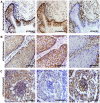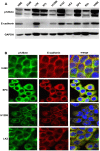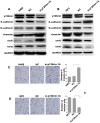Impact of p120-catenin isoforms 1A and 3A on epithelial mesenchymal transition of lung cancer cells expressing E-cadherin in different subcellular locations
- PMID: 24505377
- PMCID: PMC3913724
- DOI: 10.1371/journal.pone.0088064
Impact of p120-catenin isoforms 1A and 3A on epithelial mesenchymal transition of lung cancer cells expressing E-cadherin in different subcellular locations
Abstract
The epithelial mesenchymal transition (EMT) is an important process in tumor development. Despite previous investigations, it remains unclear how p120-catenin (p120ctn) isoforms 1A and 3A affect the EMT of tumor cells. Here we investigated expression of p120ctn, E-cadherin and vimentin in 78 human non-small cell lung cancer (NSCLC) samples by immunohistochemistry and found that p120ctn membrane expression positively correlated with E-cadherin expression (P<0.001) and negatively correlated with vimentin expression and lymph node metastasis (P<0.05). Meanwhile, p120ctn cytoplasmic expression negatively correlated with E-cadherin expression (P<0.001) and positively correlated with vimentin expression and lymph node metastasis (P<0.05). Cells expressing high (H460 and SPC) and low (H1299 and LK2) levels of p120ctn were screen to investigate its impact on EMT. E-cadherin was restricted to the cell membrane in H460 and H1299 cells, whereas it was expressed in the cytoplasm of SPC and LK2 cells. Ablation of endogenous p120ctn isoform 1A in cells expressing high levels of the protein resulted in decreased E-cadherin expression, increased N-cadherin, vimentin and snail expression and enhanced invasiveness in H460 cells. Meanwhile, completely opposite results were observed in SPC cells. Furthermore, transfection of in H1299 cells expressing low p120ctn levels with the p120ctn isoform 1A plasmid resulted in increased E-cadherin expression, decreased N-cadherin, vimentin and snail expression and weakened invasiveness, while LK2 cells showed completely opposite results. Both cell lines expressing low p120ctn levels and transfected with the p120ctn isoform 3A plasmid appeared to have increased E-cadherin expression, decreased N-cadherin, vimentin and snail expression and weakened invasiveness. In conclusion, in cells with membrane E-cadherin, both p120ctn isoforms 1A and 3A inhibited EMT and decreased cell invasiveness. In cells with cytoplasmic E-cadherin, p120ctn isoform 1A promoted EMT and increased cell invasiveness, while p120ctn isoform 3A inhibited the EMT and decreased cell invasiveness.
Conflict of interest statement
Figures




Similar articles
-
N-terminal 1-54 amino acid sequence and Armadillo repeat domain are indispensable for P120-catenin isoform 1A in regulating E-cadherin.PLoS One. 2012;7(5):e37008. doi: 10.1371/journal.pone.0037008. Epub 2012 May 16. PLoS One. 2012. PMID: 22615871 Free PMC article.
-
p120ctn isoform 1 expression significantly correlates with abnormal expression of E-cadherin and poor survival of lung cancer patients.Med Oncol. 2010 Sep;27(3):880-6. doi: 10.1007/s12032-009-9300-2. Epub 2009 Sep 11. Med Oncol. 2010. PMID: 19763914
-
P120-catenin isoforms 1A and 3A differently affect invasion and proliferation of lung cancer cells.Exp Cell Res. 2009 Mar 10;315(5):890-8. doi: 10.1016/j.yexcr.2008.12.016. Epub 2009 Jan 3. Exp Cell Res. 2009. PMID: 19150613
-
Functions of p120ctn in development and disease.Front Biosci (Landmark Ed). 2012 Jan 1;17(2):760-83. doi: 10.2741/3956. Front Biosci (Landmark Ed). 2012. PMID: 22201773 Review.
-
Functions of p120ctn isoforms in cell-cell adhesion and intracellular signaling.Front Biosci (Landmark Ed). 2012 Jan 1;17(5):1669-94. doi: 10.2741/4012. Front Biosci (Landmark Ed). 2012. PMID: 22201829 Review.
Cited by
-
The Ras-related gene ERAS is involved in human and murine breast cancer.Sci Rep. 2018 Aug 29;8(1):13038. doi: 10.1038/s41598-018-31326-4. Sci Rep. 2018. PMID: 30158566 Free PMC article.
-
Divergent roles of p120-catenin isoforms linked to altered cell viability, proliferation, and invasiveness in carcinogen-induced rat skin tumors.Mol Carcinog. 2017 Jul;56(7):1733-1742. doi: 10.1002/mc.22630. Epub 2017 Mar 6. Mol Carcinog. 2017. PMID: 28218467 Free PMC article.
-
Lysimachia christinae Hance as an anticancer agent against breast cancer cells.Food Sci Nutr. 2020 Sep 10;8(10):5717-5728. doi: 10.1002/fsn3.1875. eCollection 2020 Oct. Food Sci Nutr. 2020. PMID: 33133573 Free PMC article.
-
Delta-catenin is required for cell proliferation in virus positive Merkel cell carcinoma cell lines but not in human fibroblasts.bioRxiv [Preprint]. 2025 Mar 14:2025.03.12.642815. doi: 10.1101/2025.03.12.642815. bioRxiv. 2025. Update in: mBio. 2025 Jun 11;16(6):e0083225. doi: 10.1128/mbio.00832-25. PMID: 40161767 Free PMC article. Updated. Preprint.
-
Brain metastases from lung cancer show increased expression of DVL1, DVL3 and beta-catenin and down-regulation of E-cadherin.Int J Mol Sci. 2014 Jun 13;15(6):10635-51. doi: 10.3390/ijms150610635. Int J Mol Sci. 2014. PMID: 24933634 Free PMC article.
References
-
- Thiery JP, Sleeman JP (2006) Complex networks orchestrate epithelial-mesenchymal transitions. Nat Rev Mol Cell Biol 7: 131–142. - PubMed
-
- Shook D, Keller R (2003) Mechanisms, mechanics and function of epithelial-mesenchymal transitions in early development. Mech Dev 120: 1351–1383. - PubMed
-
- Valdes F, Alvarez AM, Locascio A, Vega S, Herrera B, et al. (2002) The epithelial mesenchymal transition confers resistance to the apoptotic effects of transforming growth factor Beta in fetal rat hepatocytes. Mol Cancer Res 1: 68–78. - PubMed
-
- Huber MA, Kraut N, Beug H (2005) Molecular requirements for epithelial-mesenchymal transition during tumor progression. Curr Opin Cell Biol 17: 548–558. - PubMed
Publication types
MeSH terms
Substances
LinkOut - more resources
Full Text Sources
Other Literature Sources
Medical
Research Materials
Miscellaneous

